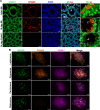CXXC1 is not essential for normal DNA double-strand break formation and meiotic recombination in mouse
- PMID: 30365547
- PMCID: PMC6221362
- DOI: 10.1371/journal.pgen.1007657
CXXC1 is not essential for normal DNA double-strand break formation and meiotic recombination in mouse
Abstract
In most mammals, including mice and humans, meiotic recombination is determined by the meiosis specific histone methytransferase PRDM9, which binds to specific DNA sequences and trimethylates histone 3 at lysine-4 and lysine-36 at the adjacent nucleosomes. These actions ensure successful DNA double strand break formation and repair that occur on the proteinaceous structure forming the chromosome axis. The process of hotspot association with the axis after their activation by PRDM9 is poorly understood. Previously, we and others have identified CXXC1, an ortholog of S. cerevisiae Spp1 in mammals, as a PRDM9 interactor. In yeast, Spp1 is a histone methyl reader that links H3K4me3 sites with the recombination machinery, promoting DSB formation. Here, we investigated whether CXXC1 has a similar function in mouse meiosis. We created two Cxxc1 conditional knockout mouse models to deplete CXXC1 generally in germ cells, and before the onset of meiosis. Surprisingly, male knockout mice were fertile, and the loss of CXXC1 in spermatocytes had no effect on PRDM9 hotspot trimethylation, double strand break formation or repair. Our results demonstrate that CXXC1 is not an essential link between PRDM9-activated recombination hotspot sites and DSB machinery and that the hotspot recognition pathway in mouse is independent of CXXC1.
Conflict of interest statement
The authors have declared that no competing interests exist.
Figures







Similar articles
-
The Meiotic Recombination Activator PRDM9 Trimethylates Both H3K36 and H3K4 at Recombination Hotspots In Vivo.PLoS Genet. 2016 Jun 30;12(6):e1006146. doi: 10.1371/journal.pgen.1006146. eCollection 2016 Jun. PLoS Genet. 2016. PMID: 27362481 Free PMC article.
-
CXXC finger protein 1-mediated histone H3 lysine-4 trimethylation is essential for proper meiotic crossover formation in mice.Development. 2020 Mar 17;147(6):dev183764. doi: 10.1242/dev.183764. Development. 2020. PMID: 32094118
-
The PRDM9 KRAB domain is required for meiosis and involved in protein interactions.Chromosoma. 2017 Dec;126(6):681-695. doi: 10.1007/s00412-017-0631-z. Epub 2017 May 19. Chromosoma. 2017. PMID: 28527011 Free PMC article.
-
PRDM9 and Its Role in Genetic Recombination.Trends Genet. 2018 Apr;34(4):291-300. doi: 10.1016/j.tig.2017.12.017. Epub 2018 Jan 21. Trends Genet. 2018. PMID: 29366606 Free PMC article. Review.
-
Spp1 at the crossroads of H3K4me3 regulation and meiotic recombination.Epigenetics. 2013 Apr;8(4):355-60. doi: 10.4161/epi.24295. Epub 2013 Mar 19. Epigenetics. 2013. PMID: 23511748 Free PMC article. Review.
Cited by
-
EWSR1 affects PRDM9-dependent histone 3 methylation and provides a link between recombination hotspots and the chromosome axis protein REC8.Mol Biol Cell. 2021 Jan 1;32(1):1-14. doi: 10.1091/mbc.E20-09-0604. Epub 2020 Nov 11. Mol Biol Cell. 2021. PMID: 33175657 Free PMC article.
-
Recent advances in mechanisms ensuring the pairing, synapsis and segregation of XY chromosomes in mice and humans.Cell Mol Life Sci. 2024 Apr 23;81(1):194. doi: 10.1007/s00018-024-05216-0. Cell Mol Life Sci. 2024. PMID: 38653846 Free PMC article. Review.
-
Advances Towards How Meiotic Recombination Is Initiated: A Comparative View and Perspectives for Plant Meiosis Research.Int J Mol Sci. 2019 Sep 23;20(19):4718. doi: 10.3390/ijms20194718. Int J Mol Sci. 2019. PMID: 31547623 Free PMC article. Review.
-
Dual histone methyl reader ZCWPW1 facilitates repair of meiotic double strand breaks in male mice.Elife. 2020 Apr 30;9:e53360. doi: 10.7554/eLife.53360. Elife. 2020. PMID: 32352380 Free PMC article.
-
PRDM9 forms a trimer by interactions within the zinc finger array.Life Sci Alliance. 2019 Jul 15;2(4):e201800291. doi: 10.26508/lsa.201800291. Print 2019 Aug. Life Sci Alliance. 2019. PMID: 31308055 Free PMC article.
References
Publication types
MeSH terms
Substances
Grants and funding
LinkOut - more resources
Full Text Sources
Molecular Biology Databases
Research Materials
Miscellaneous

